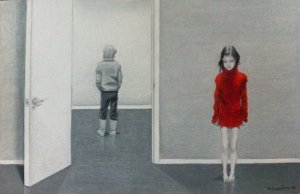
Zombies are a source of fictional terror when you’re shooting them down “Walking Dead”-style. But what about caring for an undead family member- a spouse, a sibling, a child- when you suspect that there’s spiritually nothing left of them anymore? What would you risk- with the government swooping in to confiscate your dead and take them to a containment unit- if you had the tiniest iota of reason to believe that what they were when they lived was somewhere within them, waiting to be coaxed out?
This is the chilling premise of “Let the Right One In” author John Ajvide Lindqvist’s intriguing take on the zombie genre, “Handling the Undead.” Husband, father, and stand-up comic David’s worst fears are realized when his wife, Eve, is killed in a car accident. But things start to get seriously weird when Eve gets up- after being pronounced dead- and astounds the institute’s doctors.
Similar cases occur all over Sweden, where the dead wake in morgues or in their graves, suddenly alive, and initially harmless, but changed- shells of their former selves. Most of the book is focused on how the citizens deal with their feelings of grief and horror at this shocking occurrence.
Morbidly obese sadsack and newspaper reporter Gustav Mahler rushes to unbury his deceased grandson, Elias, while telepathic widow Elvy (Christian grandmother of a similarly gifted, emo teen, Flora) is reluctant to accept her newly-zombified husband into her life. As it is revealed that the living can read each other’s thoughts while in the company of the undead, causing further discord, the government frets about what to do about the socially marginalized hoards.
I actually liked this book better than Lindqvist’s previous novel, “Let the Right One In,” but not nearly as much as the Swedish film adaptation. I found this book easier to read because there were not as many extraneous characters and subplots as the former (although, to be fair, “Handling the Undead” also had a rather abrupt ending.) The characters in “Handling the Undead” range from pretty well-developed (Flora and Elvy are the highlights of the book) to hardly developed at all (Mahler’s daughter, Anna, who mostly comes of as a passive-aggressive bitch) but for the most part the cast is pretty interestingly written.
The horror of the initial premise, pays off here, with lots of gooey descriptions of zombie guts and decomposition. However, there is also a definite element of tragedy at play as well, as families struggle to cope with their loved ones’ changed natures. There seems to be an undercurrent of political commentary too. The dead (charitably called the ‘reliving’) are shuffled of to a sterile environment and are not exempt from experiments carried out by eager medical personnel.
Like the very sick and disabled, the undead are a problem society simply does not want to deal with. The solution- make the problem go away. This serves as a potent (though decidedly non-PC) allegory. However, I did not like the direct connections drawn between the undead and people with Autism.
Apparently “Handling the Undead” is going to become a TV series, which I am somewhat excited for. I suspect some of the gruesome details (such as the child, Elias’ horrific appearance,) will be gussied up or omitted completely for the sake of so-called ‘good taste’ (on the other hand, the film “Let the Right One In” did fine without the zombie-Hakan attempted rape scene or the icky details of Hakan’s pedophilic escapades from the book.) Also, can we expect a forgettable U.S remake?
To be truthful, I like funny-zombies better than serious-slash-scary-zombies. That said, I enjoy serious zombie stories (such as “The Walking Dead” or “The Returned”) if it has that special something (intriguing characters, genuine scares, or a vitally new take on the familiar story of a worldwide epidemic.) As it so happens, “Handling the Undead” has a little of that something. And I never (I mean never) read horror fiction, but count Lindquist on my radar.












